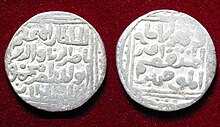Sultan Nasiruddin Mahmud Shah
| Nasir-ud-din Mahmud Shah | |
|---|---|
 Coin of Nasir ud Din Mahmud | |
| 8th Sultan of Delhi | |
| Reign | 10 June 1246 – 18 February 1266 |
| Coronation | 10 June 1246 in Delhi |
| Predecessor | Ala ud din Masud |
| Successor | Ghiyasuddin Balban |
| Born | 1229 or 1230 Delhi |
| Died | 18 February 1266 (aged 35–37) Delhi |
| Spouse | Malikah-i-Jahan Khani,[1] daughter of Ghiyasuddin Balban |
| House | Mamluk Dynasty (Delhi) |
| Father | Shamsuddin Iltutmish[2] |
| Mother | Malikah-i-Jahan Jalal-ud-Dunya-wa-uddin[3] |
Nasir ud din Mahmud Shah[4] (1229/1230 – 19 November 1266, reigned: 1246–1265)[5] was the eighth sultan of the Mamluk Sultanate (Slave dynasty).The Tabaqat-i Nasiri, written by the court historian Minhaj-i-Siraj, is dedicated to him. It is the only available contemporary source of history of his reign and thus undoubtedly the most reliable source.[6] He was a son of Shamsuddin Iltutmish, (as clearly mentioned by Minhaj in Tabaqat-i-Nasiri).[7] He ascended to the throne of Delhi Sultanate in 1246 at the tender age of 17 or 18 after the chiefs replaced Ala ud din Masud, when they felt that Masud began to behave as a tyrant.
As a ruler, Mahmud was known to be very religious, spending most of his time in prayer and copying the Quran. However, it was actually his father-in-law and Naib, Ghiyas ud din Balban, who primarily dealt with the state affairs.[8]
After Mahmud's death in 1266, Balban (1266–87) rose to power as Mahmud had no surviving children to be his heir.
Early life[]
Nasiruddin Mahmud was a son of Iltutmish (not the youngest as Iltutmish's youngest son was Qutubuddin, who was blinded and killed by Shah Turkan). His mother was a concubine ( who later, during his son's reign, was given the title of Malikah-i-Jahan).[9]
He was born in the year of 626 Hijri (1229 A.D.), in Delhi's Kasr-Bagh (the Garden Castle), few times after the untimely death of Iltutmish's eldest son and heir apparent Nasiruddin Mahmud Shah, who governed Bengal and Oudh under Iltutmish's sovereignty. Iltutmish, being greatly aggrieved by the sudden loss of his favourite son, bestowed upon the son with the title of the deceased prince. Infant Mahmud, along with his mother, was sent to the castle of nearby town Luni. He was brought up and received his education there. On May 10,1242, Sultan Muiz ud din Bahram was dethroned. Amirs and Maliks took the possession of Delhi from him. Mahmud, along with his brother Jalal-ud-Din Masud Shah and nephew Ala ud din Masud (son of Ruknuddin Firuz) was brought to Firuzi castle, the royal residence, from the confinement of the white castle by the amirs and Ala ud din Masud was chosen as the Sultan. Both the brothers remained in confinement until September 1243, when Masud ordered them to be released and conferred upon Mahmud the city of Bharaij and its dependencies. Mahmud left Delhi and went to his fief with his mother. He undertook expeditions against the rebels in that territory and the adjacent mountains.[10]
Personal life[]
Unlike many of his predecessors and successors, Mahmud strictly followed monogamy. He spent most of his time writing down verses of the Quran. He sold the handwritten copies and used the money for his personal expenses. Surprising enough, he had no servants to carry out his personal tasks. His wife had to cook the food for the family.[11][unreliable source?]
See also[]
- Mamluk dynasty
- History of India
- Islamic history
- List of Indian monarchs
References[]
- ^ Minhaj-i-Siraj, "Tabaqat-i-Nasiri" translated by Major HG Raverty (1873)p.686,714
- ^ Minhaj-i-Siraj, "Tabaqat-i-Nasiri" translated by Major HG Raverty (1873)p.625,669,670
- ^ Minhaj-i-Siraj, "Tabaqat-i-Nasiri" translated by Major HG Raverty (1873)p.676
- ^ Minhaj-i-Siraj Jurjani, Abu-'Umar-i-'Usman (1873). The Tabakat-i-Nasiri. Translated by Major H.G. Raverty. London: Asiatic Society. pp. 669–670.
- ^ Hanifi, Manzoor Ahmad (1964). A Short History of Muslim Rule in Indo-Pakistan. Ideal Library. p. 43.
- ^ Minhaj-i-Siraj Jurjani, Abu-'Umar-i-'Usman (1873). The Tabakat-i-Nasiri. Translated by Major H. G. Raverty. London: Asiatic Society of Bengal. pp. 669–670.
- ^ Minhaj-i-Siraj Jurjani, Abu-'Umar-i-'Usman (1873). The Tabaqat-i-Nasiri. London: Asiatic Society of Bengal. pp. 633–676.
- ^ Sen, Sailendra (2013). A Textbook of Medieval Indian History. Primus Books. pp. 74–76. ISBN 978-9-38060-734-4.
- ^ Minhaj-i-Siraj Jurjani, Abu-'Umar-i-'Usman (1873). The Tabaqat-i-Nasiri translated by Major H.G. Raverty. London: Asiatic Society of Bengal. pp. 633–676.
- ^ Minhaj-i-Siraj Jurjani, Abu-'Umar-i-'Usman (1873). The Tabakat-i-Nasiri. Translated by Major H.G. Raverty. London: Asiatic Society of Bengal. pp. 633–676.
- ^ Vandhargal Vendrargal. Chennai: Vikatan Prasuram. 2012. p. 27. ISBN 978-81-89780-59-3.
External links[]
- Sultans of the Mamluk dynasty (Delhi)
- 1266 deaths
- 1246 births
- Indian Sunni Muslims
- 13th-century Indian monarchs
- Indian royalty stubs